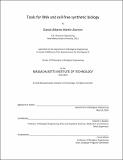Tools for RNA and cell-free synthetic biology
Author(s)
Martin Alarcon, Daniel Alberto
DownloadFull printable version (27.95Mb)
Other Contributors
Massachusetts Institute of Technology. Department of Biological Engineering.
Advisor
Edward S. Boyden.
Terms of use
Metadata
Show full item recordAbstract
Amid the myriad recent developments in synthetic biology, progress has been fastest in the areas with the most versatile tools for understanding and engineering biological systems. RNA synthetic biology and synthetic minimal cells are areas where design is limited by the availability of tools to observe, program, and manipulate the systems in question. In this work I present expanded toolsets to achieve these goals. The ability to monitor and perturb RNAs in living cells would benefit greatly from a modular, programmable protein architecture for targeting unmodified RNA sequences. I report that the RNA-binding protein PumHD (Pumilio homology domain), which has been widely used in native and modified form for targeting RNA, can be engineered to yield a set of four canonical protein modules, each of which targets one RNA base. These modules (which I call Pumby, for Pumilio-based assembly) can be concatenated in chains of varying composition and length, to bind desired target RNAs. I validate that the Pumby architecture can perform RNA-directed protein assembly and enhancement of translation of RNAs. I further demonstrate a new use of such RNA-binding proteins, measurement of RNA translation in living cells. Pumby may prove useful for many applications in the measurement, manipulation, and biotechnological utilization of unmodified RNAs in intact cells and systems. Genetic circuits are a fundamental tool in synthetic biology; an open question is how to maximize the modularity of their design, to facilitate their integrity, scalability, and flexibility. Liposome encapsulation enables chemical reactions to proceed in well-isolated environments. I here adapt liposome encapsulation to enable the modular, controlled compartmentalization of genetic circuits and cascades. I demonstrate that it is possible to engineer genetic circuit-containing synthetic minimal cells (synells) so that they contain multiple-part genetic cascades, that these cascades can be controlled by external as well as inter-liposomal communication without cross-talk, and that these cascades can also be fused in a controlled way so that the products of incompatible reactions can be brought together. Synells thus enable more modular creation of synthetic biology cascades, an essential step towards their ultimate programmability.
Description
Thesis: Ph. D., Massachusetts Institute of Technology, Department of Biological Engineering, 2016. This electronic version was submitted by the student author. The certified thesis is available in the Institute Archives and Special Collections. Cataloged from student-submitted PDF version of thesis. Includes bibliographical references (pages 58-63).
Date issued
2016Department
Massachusetts Institute of Technology. Department of Biological EngineeringPublisher
Massachusetts Institute of Technology
Keywords
Biological Engineering.